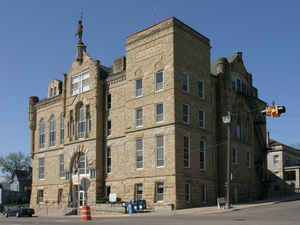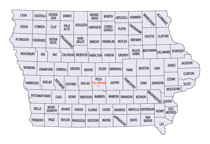Iowa Counties
There are ninety-nine counties in Iowa. The first two counties, Des Moines County and Dubuque County, were created in 1834 when Iowa was still part of the Michigan Territory. In preparation for Michigan's statehood, part of Michigan Territory was formed into Wisconsin Territory in 1836]. Two years later, the western portion was split off to become Iowa Territory. The south-eastern part of Iowa Territory became Iowa, the 29th state in the union, on 28 December 1846, by which point 44 Counties had been created. Counties continued to be created by the state government until 1857, when the last county, Humboldt County, was created.Wapello County, Iowa
Wapello County Education, Geography, and History
Wapello County is a county located in the state of Iowa. Based on the 2010 census, the
population was 35,625. The county was created on February 17, 1843. The
county seat is Ottumwa. Wapello is
named for Wapello, a Meskwaki chief in the Black Hawk
War.
Wapello County is included in the Ottumwa, IA Micropolitan Statistical Area.
Etymology - Origin of Wapello County Name
Wapello county is named for Wapello, a Native American chief in the Black Hawk War.
Demographics:
County QuickFacts: CensusBureau Quick Facts
Wapello County History
Wapello County is named in honor of
Fox Indian Chief "Wau-ba-law," "Waupello," or "Wa-pel-lo." Chief Wapello was the
second-in-command over the combined Sac and Fox Indians.
The county was opened at midnight on April 30, 1843. Eager settlers camped along
the county border; and, at the sound of a shotgun, they raced towards the "New
Purchase." Within a month of this settlement, 5,000 people were living within
Wapello's borders.
The county originated in 1844. Three commissioners selected a site for the
county seat. It was originally known as Appanoose Rapids, then Louisville. When
the settlers arrived, the name was changed to Ottumwanoc, later shortened to the
present Ottumwa.
A simple log cabin was the county's first courthouse. It was not long before it
was abandoned in favor of a more suitable building.
The first permanent courthouse was a brick structure that cost an estimated
$1,000. This building was used until 1855, when it was sold to the Christian
Church.
During the fall of 1881, Wapello County experienced a gold rush. A speculator
claimed he discovered gold along Bear Creek. The prices for land and mineral
rights soared until an investigation proved the scheme to be a fraud.
In 1855 the county constructed its second real courthouse. This building was
also two stories, but twice the size of the previous building. This building was
used until 1891. It was then demolished to make way for the third and current
courthouse.
In an election, voters approved $100,000 worth of bonds to be used towards the
construction of a new courthouse. The cornerstone was laid on September 28,
1892, and it was officially dedicated two years later on May 17, 1894.
Rough cut sandstone was used for the five-story building. A large corner clock
tower was part of the original design. In 1950 the clock tower and several
chimneys were removed. About 450 tons of bricks were removed to help alleviate
stress on the building. At the apex of the building stands an Indian statue
representing Chief Wapello.
Source: Phyllis Dean, Wapello County Auditor, 2002
Geography: Land and Water
As reported by the Census Bureau, the county has a total area of 436 square miles (1,130 km2), of which 432 square miles (1,120 km2) is land and 4.2 square miles (11 km2) (1.0%) is water.
Wapello county is located in southeast Iowa. Des Moines River runs
through this county.
Neighboring Counties
Bordering counties are as follows:
- Northeast: Keokuk County
- East: Jefferson County
- Southeast: Van Buren County
- South: Davis County
- Southwest: Appanoose County
- West: Monroe County
- Northwest: Mahaska County
Education







